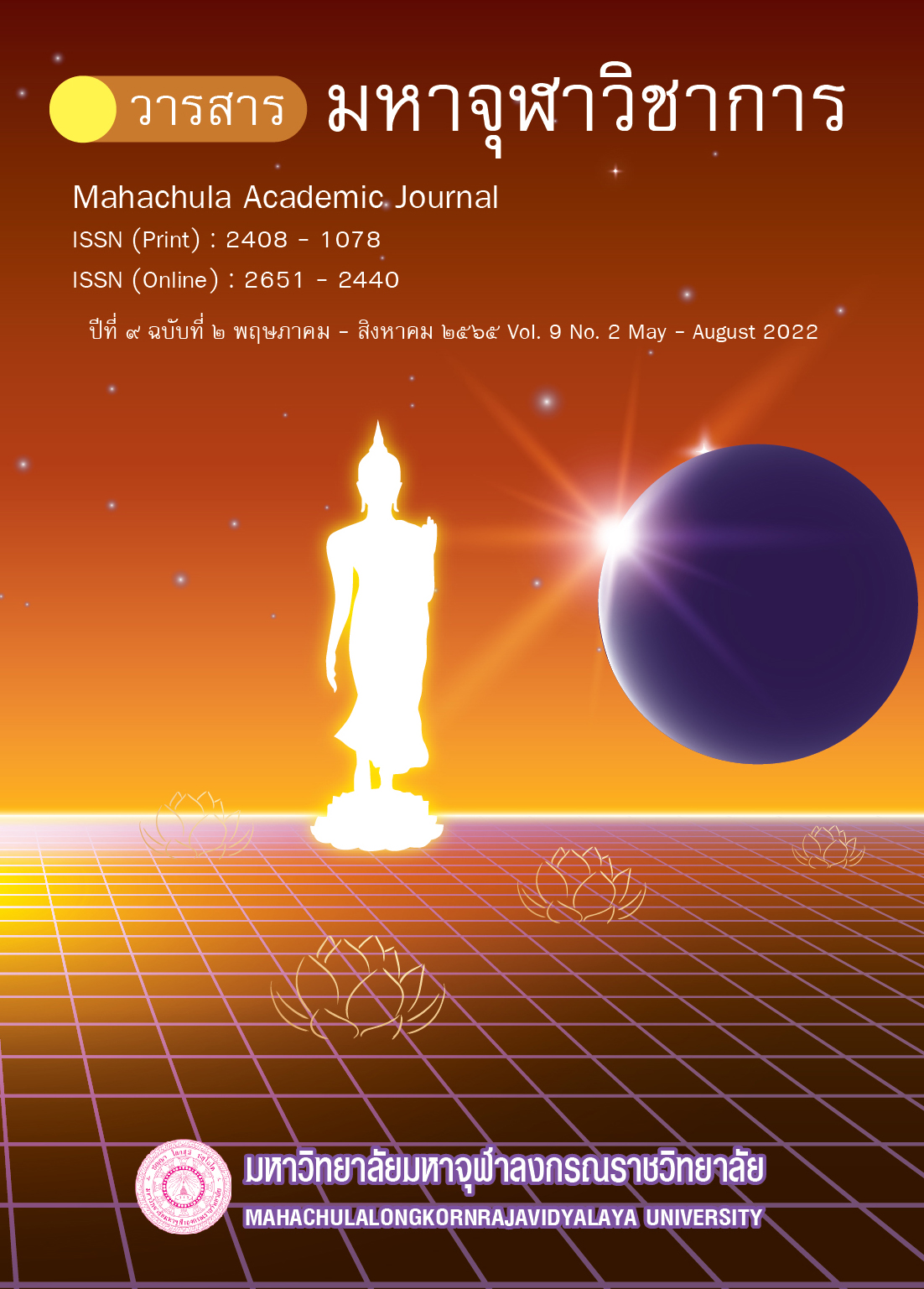Model of Management of Cultural Tourism based on the Buddha’s footprint In Wat Phrabuddhabat, Saraburi province
Main Article Content
Abstract
Article Details

This work is licensed under a Creative Commons Attribution-NonCommercial-NoDerivatives 4.0 International License.
References
คณะกรรมการปริวรรตแปลคัมภีร์. พุทธตำนาน: พระเจ้าเลียบโลก. มหาวิทยาลัยมหาจุฬาลงกรณราชวิทยาลัย วิทยาเขตแพร่ : แพร่, ๒๕๕๕.
คณะกรรมการนโยบายการท่องเที่ยวแห่งชาติ. แผนพัฒนาการท่องเที่ยวแห่งชาติ (พ.ศ. ๒๕๖๔ – ๒๕๖๕). กรุงเทพมหานคร : สำนักงานปลัดกระทรวงการเที่ยวและการกีฬา, ๒๕๖๕.
คุณัญญา จินตนา. “ศึกษาการใช้สื่อประชาสัมพันธ์เพื่อส่งเสริมการท่องเที่ยวเชิงวัฒนธรรม กรณีศึกษา : วัดพระพุทธบาทราชวรมหาวิหาร จังหวัดสระบุรี”. วิทยานิพนธ์นิเทศศาสตรมหาบัณฑิต. สาขาวิชาการสื่อสารการท่องเที่ยวและบันเทิง. คณะนิเทศศาสตร์ : มหาวิทยาลัยเกริก, ๒๕๕๑.
จวน คงแก้ว. “ศึกษาวิเคราะห์พุทธบาทลักษณะที่สัมพันธ์กับหลักพุทธธรรม”. วิทยานิพนธ์พุทธศาสตรดุษฎีบัณฑิต สาขาวิชาพระพุทธศาสนา. บัณฑิตวิทยาลัย : มหาวิทยาลัยมหาจุฬาลงกรณราชวิทยาลัย, ๒๕๕๙.
จวน คงแก้ว. “พุทธศิลป์ในรอยพระพุทธบาท”. Journal of Thai Interdisciplinary Research, Vol. 11 No.4 [July – August 2016]: 74.
จีณัสมา ศรีหิรัญ, คมม์ เพชรอินทร, สินีนาถ เสือสูงเนิน, นรัญญา พลเยี่ยม และศิริธร โคกขุนทด. “การท่องเที่ยวเชิงศาสนา ตามรอยวรรณกรรมพื้นถิ่นและบุญบั้งไฟ อำเภอรัตนวาปี จังหวัดหนองคาย”. วารสารบัณฑิตศึกษาปริทรรศน์. ปีที่ ๑๗ ฉบับที่ ๒ (พฤษภาคม – สิงหาคม ๒๕๖๔) : ๕ – ๗.
แผนพัฒนาจังหวัดสระบุรี (พ.ศ. ๒๕๖๑ – ๒๕๖๔). สระบุรี : สำนักงานจังหวัดสระบุรี, ๒๕๕๙.
มหาจุฬาลงกรณ์ราชวิทยาลัย. พระไตรปิฎกภาษาไทย ฉบับมหาจุฬาลงกรณราชวิทยาลัย เล่มที่ ๑๑. กรุงเทพมหานคร : โรงพิมพ์มหาจุฬาลงกรณ์ราชวิทยาลัย, ๒๕๓๙.
พระชาญชัย จนฺทสโร (บุญหล้า). พระครุศรีคัมภีรญาณ. โสวิทย์ บำรุงภักดิ์ และพระมหาสำรอง สญฺญโต. “การศึกษาวิเคราะห์คติความเชื่อและคุณค่าของการบูชารอยพระพุทธบาทของชาวพุทธ อำเภอสหัสขันธ์ จังหวัดกาฬสินธุ์”. วารสารพัฒนาการเรียนรู้สมัยใหม่. ปีที่ ๕ ฉบับที่ ๕ (กันยายน – ตุลาคม ๒๕๖๓) : ๒๖๐ – ๒๖๙.
พระมหาเสงี่ยม สุวโจ (มณีวงษ์), พระครูพิพิธปริยัติกิจ, กมลาศ ภูวชนาธิพงศ์. “รูปแบบการพัฒนาวัดสร้างสุขด้วยสัปปายะตามแนวพุทธจิตวิทยา”. วารสารนาครทรรศน์. ปีที่ ๖ ฉบับที่ ๖ (สิงหาคม ๒๕๖๒) : ๒๘๓๐.
พระศรีปริยัติเวที (ลำไย สุวฑฺฒโน). “ศึกษาวิเคราะห์ความเชื่อในรอยพระพุทธบาทของคนไทย”. วิทยานิพนธ์พุทธศาสตรดุษฎีบัณฑิต. สาขาวิชาพระพุทธศาสนา. บัณฑิตวิทยาลัย : มหาวิทยาลัยมหาจุฬาลงกรณราชวิทยาลัย, ๒๕๕๒.
ว่าที่ ร.ต. ณัฐวรรณ์ สงึมรัมย์. “การจัดการท่องเที่ยวทางพระพุทธศาสนาของวัดพระพุทธบาท วัดศาลาแดง และวัดพระพุทธฉาย”. วิทยานิพนธ์พุทธศาสตรดุษฎีบัณฑิต. สาขาวิชาพระพุทธศาสนา. บัณฑิตวิทยาลัย : มหาวิทยาลัยมหาจุฬาลงกรณราชวิทยาลัย, ๒๕๖๒.
สำนักนายกรัฐมนตรี. ประวัติวัดพระพุทธบาท. สำนักนายกรัฐมนตรีพิมพ์แจกในงานถวายผ้าพระกฐินพระราชทานของสำนักนายกรัฐมนตรี ณ วัดพระพุทธบาทราชวรมหาวิหาร อำเภอพระพุทธบาท จังหวัดสระบุรี, ๘ พฤศจิกายน ๒๕๒๓.
Claudio Cicuzza. A Mirror Reflecting the Entire World, the Pali Buddhapādamańgala or Auspicious Signs on The Buddha’s Feet. Bangkok, Thailand: Fragile Palm Leaves Foundation, Lumbini International Research Institute, 2011.
Jutharat Thonginchan. “A Critical Study of Buddhist Principles from the Buddha’s Footprints”. A Dissertation Doctor of Philosophy. Graduate School: Mahachulalongkornrajavidayalaya University, 2018.
Unchalee Pinrod. “Buddhapādamańgala: An Edition and a Critical Study”. Thesis Master of Arts. Graduate School: Chulalongkorn University, 1982.
S. Sirikudta & P, Archarungroj & Sirisuthikul, Varintra. “Sustainable Creative Tourism for Fulfilling the Gap between Tourists’ Expectation and Perception towards Tourism Routes in the Upper Greater Mekong Sub region”. International Journal of Humanities, Arts and Social Sciences, 5 (2019): 43-53.
Waldemer C. Sailer. The Word of the Buddha footprint, Source: [Online]. Available: www.dralbani.com/Buddha Footprint [14 August 2021], and “Chronology of Buddha Footprint”, academic article in “Buddhapadalakkhana and the Buddha’s footprint in Thailand”. Bangkok: Department of Arts, 1993.
Duxbury Nancy and team. Creative Tourism Development Models towards Sustainable and Regenerative Tourism, Sustainability 2021, 13, 2. [Online]. Available: https://dx.doi.org/10.3390/su13010002 https://www.mdpi.com/journal/sustainability [6 May 2022].
Bunpo Kojima. Some Thoughts on Buddha's Footprints. [Online]. Available: https://www.jstage.jst.go.jp/article/ibk1952/10/2/10_2_736/_pdf/-char/ja, [8 August 2021].


